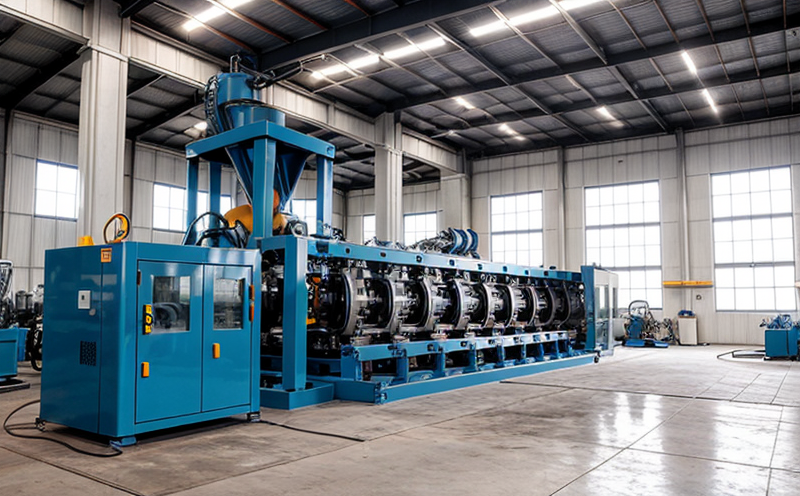EN 1493 Vehicle Lift Equipment Performance Testing
The EN 1493 standard is a European technical specification that sets out the requirements for the performance testing of vehicle lifts used in automotive and industrial manufacturing. This service ensures that lift equipment meets stringent quality, safety, and operational standards critical to maintaining high levels of reliability and efficiency during vehicle maintenance, repair, and servicing operations.
Vehicle lifts are essential tools in the modern automotive and industrial manufacturing sectors. They support various tasks such as engine replacement, tire changing, undercarriage inspections, and body repairs. The performance testing outlined by EN 1493 is crucial to guarantee that these lifts function safely and effectively over their operational life.
The testing procedure involves a series of rigorous checks designed to evaluate the mechanical integrity, load capacity, stability, and overall reliability of the lift equipment. This includes static and dynamic load tests, endurance tests, and safety checks. By adhering to EN 1493, businesses can ensure compliance with European regulations and maintain a high level of trust among their clients.
Quality managers, compliance officers, R&D engineers, and procurement professionals benefit greatly from this service. It not only ensures regulatory compliance but also enhances the reputation of manufacturers by demonstrating a commitment to quality and safety standards. This is particularly important in sectors where precision and reliability are paramount.
The testing process involves multiple stages that cover different aspects of lift performance:
- Static load testing: Ensures the lift can support specified loads without deformation or failure.
- Dynamic load testing: Checks the lift's ability to handle dynamic forces and vibrations during operation.
- Endurance tests: Evaluates the long-term reliability of the lift under continuous use conditions.
| Standard Code | Description |
|---|---|
| EN 1493-1 | General requirements and test methods for vehicle lifts |
| EN 1493-2 | Load testing of vehicle lifts |
| ISO 9001:2015 | Quality management systems |
The rigorous nature of these tests ensures that lift equipment is safe and reliable, reducing the risk of accidents and downtime. Compliance with EN 1493 also enhances customer confidence in the products offered by manufacturers.
In summary, the EN 1493 vehicle lift performance testing service is essential for ensuring safety, reliability, and regulatory compliance in automotive and industrial manufacturing settings. By adhering to this standard, businesses can enhance their reputation and maintain a competitive edge in a highly regulated industry.
Why It Matters
The importance of the EN 1493 vehicle lift performance testing cannot be overstated. Vehicle lifts are critical tools that support various automotive and industrial manufacturing processes, from routine maintenance to complex repairs. Ensuring these lifts meet stringent standards is crucial for several reasons:
- Safety: Lifts must operate safely under all conditions without compromising the safety of mechanics or technicians.
- Reliability: The lift's performance should be consistent and reliable, minimizing downtime and ensuring that maintenance tasks are completed efficiently.
- Regulatory Compliance: Meeting EN 1493 ensures compliance with European regulations and standards, which is essential for operating in the region.
- Customer Trust: Demonstrating commitment to quality and safety can enhance customer trust and loyalty.
The testing process is designed to identify any potential weaknesses or issues that could lead to accidents or failures. By addressing these concerns proactively, businesses can ensure the highest level of performance and reliability from their lift equipment.
For quality managers, compliance officers, R&D engineers, and procurement professionals, this service provides peace of mind, knowing that the lifts they use meet rigorous standards. This is particularly important in a sector where precision and reliability are essential for maintaining operational efficiency.
Applied Standards
| Standard Code | Description |
|---|---|
| EN 1493-1 | General requirements and test methods for vehicle lifts |
| EN 1493-2 | Load testing of vehicle lifts |
| ISO 9001:2015 | Quality management systems |
The EN 1493 standard is specifically designed to ensure that the performance and safety aspects of vehicle lift equipment are met. It covers various aspects, including:
- Load capacity: Ensuring lifts can support specified loads without failure.
- Stability: Checking that the lift remains stable under dynamic conditions.
- Safety features: Evaluating the presence and functionality of safety mechanisms such as over-load protection, emergency stop buttons, and level sensors.
The standard also includes detailed test methods to ensure consistency in testing procedures. Compliance with these standards is crucial for maintaining a high level of safety and reliability in vehicle lift equipment.
Competitive Advantage and Market Impact
- Enhanced Safety: By ensuring compliance with EN 1493, businesses can reduce the risk of accidents and injuries in their workshops.
- Increased Efficiency: Reliable lifts minimize downtime and ensure that maintenance tasks are completed efficiently.
- Regulatory Compliance: Meeting European standards enhances a company's reputation for quality and reliability.
- Customer Trust: Demonstrating commitment to safety and reliability can enhance customer trust and loyalty, leading to increased business opportunities.
The market impact of adhering to EN 1493 is significant. Compliance with these standards sets a benchmark for quality and safety in the industry. It also positions businesses as leaders in their field, attracting clients who value reliability and safety.
For R&D engineers and procurement professionals, this service provides valuable insights into best practices and cutting-edge technologies that can be incorporated into new designs or supplier selection processes.





